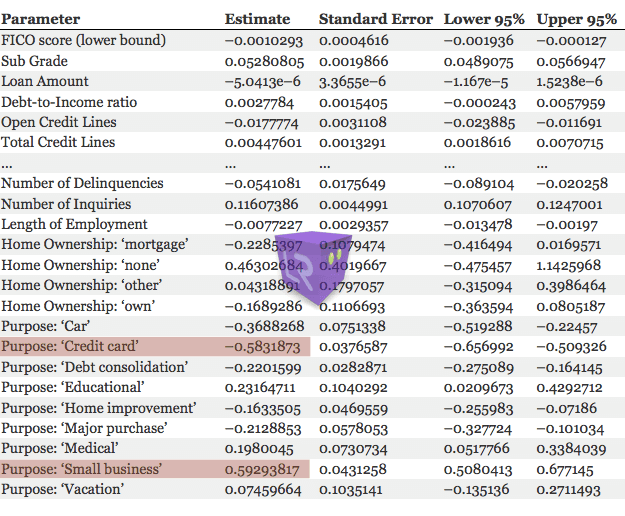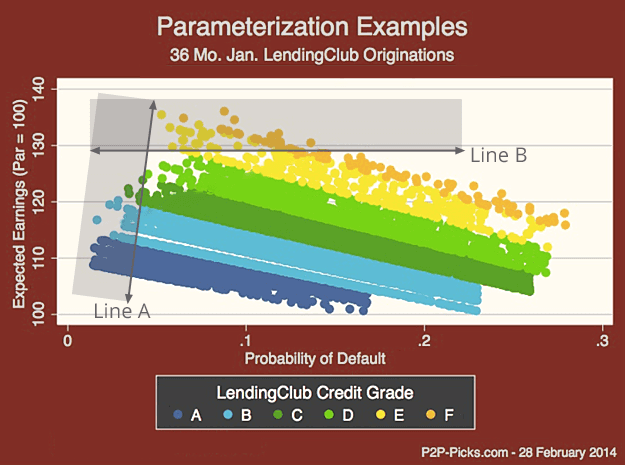Part 1: What is a secondary credit model?
Part 2: Investing through LendingRobot
For years investors have boosted their overall return by filtering the platforms for higher performing loans. This worked because Lending Club and Prosper’s earliest loan grade assignments were not completely accurate. Investors, informed by the open historical data, could take advantage of these inaccuracies to boost their overall return. The high water mark of filtering was actually in 2011 when Prosper had not considered the increased creditworthiness of their repeat borrowers, and investors were increasing their ROI by over 4% (Lend Academy) simply by focusing on repeat borrower loans.
85% of the filters I used in 2012 are very weak or unusable.
Fast forward to early 2015, both Lending Club and Prosper have significantly improved their pricing, meaning, they have become much better at assigning the correct interest rates to the different borrowers who come to them for a loan. So while a number of filters still seem to work, I would say 85% of those I used in 2012 are very weak or unusable.
This is ok. In fact, I would even say the death of simple filtering is good news overall since it indicates a larger maturation of this industry. Each year both Lending Club and Prosper get better at what they do, which is giving us access to the stable and rewarding investment of consumer credit. Having accurate interest rate assignments is part of what it means for these companies to become more stable and excellent.
Secondary Credit Models: The Future of Filtering
Does this mean filtering the platforms for higher performing loans is gone forever? By no means. Some of the biggest investors in online loans (banks, hedge funds, etc.) do indeed filter the available loans. But they don’t use highly simplistic filters like Inquiries=0. Instead, they approach the available loans with an outside credit model.
What is a credit model?
Let’s pause a moment to define the term ‘credit model’. Lending Club and Prosper deny 90% of the borrowers who come to them for a loan because of poor credit history, low income, or because they carry too much debt. The thing is, a company like Prosper does not look at this myriad of factors with human eyes, but with powerful and complex mathematical algorithms, basically a computer program that can instantly determine how likely each borrower is to repay their loan.
Every credit report contains hundreds of data points.
Remember, every borrower who comes to Lending Club or Prosper for a loan gives them their credit history, and this report contains hundreds and hundreds of data points (IE: all the fields in this Prosper back tester). Did this borrower go bankrupt in 2009? That’s in their credit report. Are they still carrying $49 in credit card debt from buying jeans last month? That’s in there too.
In short, Prosper and Lending Club’s highly accurate credit model is responsible for peer to peer lending’s consistency and low default-rate. Their credit model is what makes this a good investment.
What is a secondary credit model?
 Some of the biggest investors at Lending Club and Prosper filter the available loans using a secondary credit model/algorithm. Their model allows them to instantly calculate the likely ROI of each available loan, identifying where there is an opportunity to earn above average returns. Then they simply invest in those loans.
Some of the biggest investors at Lending Club and Prosper filter the available loans using a secondary credit model/algorithm. Their model allows them to instantly calculate the likely ROI of each available loan, identifying where there is an opportunity to earn above average returns. Then they simply invest in those loans.
Only a few of these models are available to the public. One of them is LendGuardian by Bryce Mason of P2P-Picks. LendGuardian works on both Lending Club and Prosper, statistically identifying the loans that are better investments.
For example, in the above graphic Bryce has created a scatter plot of loans on Lending Club’s platform from January 2014. The vertical axis is ROI, meaning, the mathematical return that each loan is likely to give an investor, calculated by the LendGuardian statistical algorithm. The horizontal axis is the default rate, with the algorithm again having calculated how likely each loan is to default on its payments.
The dark lines are buy-lines. Line A would be the buy-line for an investor who is trying to minimize their risk (while still earning a great return). Someone in retirement might choose to invest above Line A. In contrast, the Line B buy-line is what I personally would use. Line B solely seeks to maximize returns (ignoring risk altogether). Most investors would probably want to tilt that line a bit for a safer investment.
[Bryce’s model is widely celebrated by the public, and has been used by major investors like Titan Bank.]
How is investing through a credit model different from investing with a simple filter?
 This is a great question. The short answer is, investing with a credit model is more holistic. Instead of bluntly approaching the available loans with a single credit variable (Inquiries=0), a credit model filters the platforms using all of the borrower variables at the same time.
This is a great question. The short answer is, investing with a credit model is more holistic. Instead of bluntly approaching the available loans with a single credit variable (Inquiries=0), a credit model filters the platforms using all of the borrower variables at the same time.
A great example of this has been demonstrated by the other credit model that is available to the public: LendingRobot. As seen in this blog post, Emmanuel Marot of LendingRobot has calculated the way each loan attribute adjusts the expected default rate.

A variable with a negative value means that variable decreases the estimated default rate. A positive number increases the default rate. See the two red boxes? Credit card is the less likely loan purpose to default; loans purposed for Small business are more likely to default. Of course, the point is not to isolate a single variable like Purpose: Credit card. That would be simple filtering. The point is to show how Emmanuel’s algorithm/credit-model holistically invests on these platforms by considering all of the borrower credit variables at the same time.
[The Expected Return calculation at LendingRobot is at the center of their great investment tool, recently garnering them $3 million in investor funding]
Credit Model Investing vs. Simple Filtering
Investing through such beautiful mathematics may seem more elegant than simple filtering, but how do they actually stack up?
#1. Credit model investing is more consistent
Credit models are more consistent over time. Filters come and go. Remember how I said 85% of the filters I used in 2012 are weak or dead? If I had ignored these changes, my returns would have steeply decreased over the past two years. Filtering takes work (though I enjoy it). In contrast, if I had been investing with P2P-Picks since its launch, I would be earning an above average return for the past two years without having to adjust anything on my end whatsoever.
#2: Credit model investing’s nuance allows larger investments
In my own experience, filtering works best when the filters are somewhat tight. As a simple filter becomes wider and wider, it seems to lose its power, particularly in today’s environment where Lending Club and Prosper have become far more accurate in their loan grade assignments (IE: Simply filtering for higher incomes at Prosper may no longer work).
 In contrast, credit models can be widened farther and farther (IE: moving the buy-line in Bryce’s above graphic), allowing much larger sums of cash to be put to work than simple filtering allows. Independent investors like myself who invest less than $1,000 per week may use simple filtering just fine. But banks like Titan and savvy hedge funds with million dollar accounts need something more robust.
In contrast, credit models can be widened farther and farther (IE: moving the buy-line in Bryce’s above graphic), allowing much larger sums of cash to be put to work than simple filtering allows. Independent investors like myself who invest less than $1,000 per week may use simple filtering just fine. But banks like Titan and savvy hedge funds with million dollar accounts need something more robust.
#3: Credit model investing is much safer
The loan grades at Lending Club and Prosper are largely outside of our control. We have to trust them. And if they wanted to, these companies could degrade the quality of their loans without the consent of average investors. Yet secondary credit models would be instantly aware of such a change. If bad loans were on the platform, my simple filters would still invest in them. Those with secondary credit models would not invest at all; their cash would be safely kept off the platforms.
#4: Simple filtering is easier to understand
 This article barely touched the raw mechanics of credit modeling. The reality is, the math behind these algorithms is heavy with terminology and not understandable by the average investor. That said, simple filtering is straightfoward and easy to grasp. IE: Inquiries=0 has historically given investors a higher than average return, so we can do that ourselves by moving a slider on Lending Club’s website. Simple.
This article barely touched the raw mechanics of credit modeling. The reality is, the math behind these algorithms is heavy with terminology and not understandable by the average investor. That said, simple filtering is straightfoward and easy to grasp. IE: Inquiries=0 has historically given investors a higher than average return, so we can do that ourselves by moving a slider on Lending Club’s website. Simple.
#5: Simple filtering is more independent
Most of us are not rockstar statisticians. If we choose to invest through LendingRobot or P2P-Picks, we place a lot of trust in these companies and the math they practice. Indeed, these credit models really are black boxes, even for Bryce and Emmanuel.
But simple filtering keeps our loan selection almost purely in our own hands. Yes, many of us depend on Michael Philips to have accurate math behind NSR, but that’s about it, so the more independent investors will probably feel more comfortable with simple filtering.
Why I’m Switching to an Algorithm
Simple filters have worked for years – pretty much since peer lending began. Many feel very comfortable with it. Self-directed investors have increased their ROI (see my returns) by taking advantage of their ability to filter the list of available loans. In contrast, investing with a credit model is still novel to the average investor.
But this changing. As simple filtering becomes obsolete, using a credit model will arise as the best way to boost our return (see Bryce’s quarterly returns). I will likely switch my own filtering over to a credit model by late-2015/early-2016.
Conclusion: Celebrating the Open Data of P2P Lending
In closing, I want to take a step back and celebrate this investment and how it makes credit model investing possible, particularly at such a young stage in its growth. Since Lending Club and Prosper have published their loan data for anybody to download, people like Bryce or Emmanuel are able to offer these models to the general public.
In my opinion, this is just another example of the inherent quality in p2p lending. Not only does the open data prove this investment to be rewarding and stable, but everyday Americans are able to click a few boxes on 3rd-party websites to utilize incredibly powerful algorithms that increase their overall return.
[image credit: ‘Mathematics‘ by Tom Brown CC-BY 2.0]


I find the most important aspect of marketplace lending to be the sharing of application and historical performance data so that investors can make informed decisions. Tens of millions of dollars are being invested every day on these platforms, in an almost entirely automated fashion where microseconds make or break a transaction. Secondary credit models are crucial tools to maintain standards that are not reliant on the ratings of the agencies originating the paper. I applaud LC and Prosper for their continued transparency. At some point far in the future, the fee structures for marketplace lenders may cause a temptation to originate loans that are simply too risky. It is the openness of data that provides an appropriate check and balance against this possibility. Thank you for writing an introduction to the concept, Simon. I’m proud to serve 750+ individual retail investors with a free, independent assessment of both platforms’ debt.
Thanks Bryce. I fully agree. The return boost is nice, but the open data’s biggest benefit is how it enables us to examine the integrity of these loans irrespective of platform marketing.
Really a high quality and well written article. It matches what I have learned in the past year with a significant investment of time learning about P2P/marketplace-lending. I use a combinations of credit models and filters tweaked over 10 months to a place I am happy with. Will need another 18 months or so to see how it pans out. I consider FICO to be a another “credit model” although many may not see it that way.
Thank you LM. I’m interested in hearing more on your approach. FICO most certainly is a type of outside credit model, but it is not independent of platform pricing, so typically it gives no opportunity for arbitrage.
Nice piece, Simon.
As you know I use a credit model (my scorecard) that I created myself. Even with that I am wary of the measuring of so many parameters against defaults and expected returns on the existing data since the data skews so new with so many of the loans originated in the last 12-18 months.
Do you know how the model builders you mentioned account for that in their models? I’d be curious to know.
Stu
Thanks Stu. I’m sure you could reach out to them and ask. Both are quite transparent with the public on much (though not all) of their math.
It makes sense to me that your filters would not be nearly as effective in 2015 as they were in previous years. The company has been around longer, and in that time has collected more data that has allowed them to iterate their own credit model when figuring out who to loan to and what interest rate based on a whole bunch of variables.
It also makes sense when you compare the P2P lending market to the stock market. Before electronic trading, markets were much winder on the bid x ask. And as more and more people have come online those spreads have narrowed to as little as a penny wide. The more people on a platform, the more liquidity, which ultimately leads to a more efficient market.
Typically any edge you may have in a market early on will eventually be eliminated. It would be interesting to see how much that 4% increased ROI has shrunk over the years.
Cheers!
Great insight! The loss of filtering is just a side effect of things becoming more mature and efficient overall.
Simon as you always do, another excellent article. I really enjoyed this and learn’t a lot. Thanks
Whoops, missed this one! You’re quite welcome Glenn.
Hello all,
excellent article, like always. I think that regular filters are not completely dead but you need more than one filter and they need to be more sophisticated then in the past.
I developed and automated investment tool and I am searching for some beta test users.
Would be great if someone knows a financial expert or mathematician who is good with credit models. Would love to connect my tool with an investment algorithm in addition to regular filters.
Cheers
Fabian
Hi Fabian. So cool! You should reach out to Bryce Mason of p2p-picks.com. He has offered his model to other investing sites.
Hi Simon,
This indeed is a very interesting blog. I was actually quite surprised to find that the data on the loans was indeed open source, it’s a far cry from what happens in the field i normally work in, cancer research. They could definitely learn a thing or two about open data access, they’ve begun but have a long way to go. Also having come from a healthcare data analysis field I wondered if statistical models from that field could be applied to this one. Indeed we had a go and you can read about applying survival analysis techniques to P2P lending data here:
http://systemsforecasting.com/2016/07/application-of-survival-analysis-to-p2p-lending-club-loans-data/
The app we built is by no means the complete product nor is it meant to be but it’s a toy highlighting what you could do with survival analysis techniques. It was quite refreshing working on data other than healthcare and seeing that you can look at these problems in many different ways.
Enjoyed the other posts too!
Cheers,
Hitesh